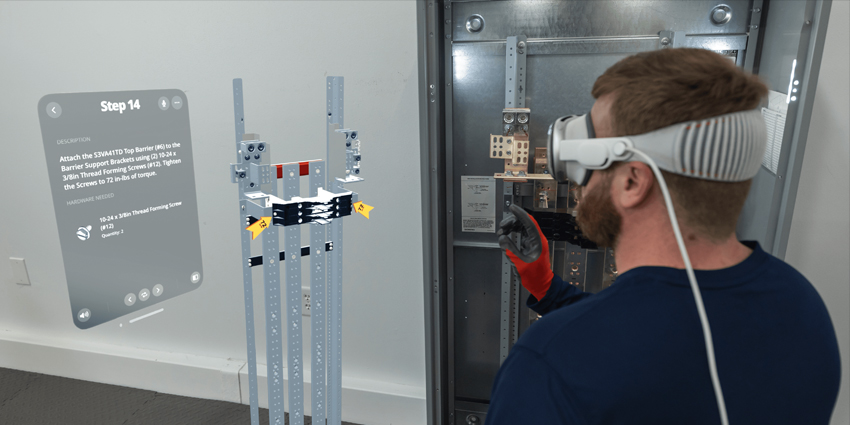Hand and eye-tracking technologies are now commonplace in the extended reality space. As companies and individuals continue to invest in advanced immersive experiences, the demand for intuitive user interfaces is growing.
Studies show that the market for gesture recognition technology is growing at 18.8%, and the eye tracking market is growing even faster, at 33.4%. This represents an increased interest in spatial computing technologies, which remove the need for controllers in extended reality.
However, unlocking the full potential of tracking tools starts with selecting the right solution. Here’s your complete guide to comparing hand and eye-tracking technology in 2023.
Step 1: Examine the Innovations in Hand and Eye Tracking
The first step in choosing the right hand and eye-tracking solutions is understanding how these technologies work. Most gesture recognition and eye-tracking solutions use a combination of sensors, artificial intelligence, hardware, and software to deliver results.
Some of the latest eye-tracking tools leverage infrared technology and high-resolution cameras to track gaze direction. Innovative tools can feature screen-based cameras built into glasses and headsets, like the Apple Vision Pro. They may also use LED lights to capture information about a person’s gaze and focus rapidly.
Hand-tracking tools also come in a variety of different forms. Some capture information using sensors and cameras placed around a user and in a headset. Innovative vendors also use EMG sensors and haptic gloves to collect motion information. Understanding how each technology works should help you make the right decisions about which tools to purchase.
Step 2: Establish Goals for your XR Technology
Once you understand how the latest hand and eye-tracking technologies work, the next step is determining what you want to accomplish with your solutions. On a basic level, these technologies can significantly improve user experience and immersion.
However, some solutions can offer additional benefits. For instance, eye-tracking technologies with built-in AI and biometric scanning solutions can improve workplace and metaverse security. Solutions with included analytics and reports can provide insights into user productivity or offer access to valuable data for business growth.
Certain eye and hand-tracking solutions can also improve the performance of your XR headsets. Foveated rendering solutions built into VR headsets can reduce the computational power required to load complex environments. They focus on generating images based on a user’s gaze rather than loading entire landscapes simultaneously.
Step 3: Explore Hand and Eye Tracking Software and Hardware
Building a truly immersive experience with hand and eye-tracking technologies often requires companies to invest in a combination of hardware and software. Most headsets today come with basic gesture tracking capabilities already built in. However, they may need some configuration to ensure you can use these resources with the crucial tools your team access.
Specific solutions will also require companies to invest in additional equipment alongside their headset. Some companies offer SDKs to bring gesture monitoring capabilities into existing software. Others need modules and base stations to get extra sensors to the environment.
Choosing a vendor who can work with you to implement a comprehensive XR environment will be essential here. The best solution provider will be able to walk you through an introduction to the core software, APIs, and SDKs you might need. They’ll also be able to work with you on purchasing and configuring hardware solutions for extended reality.
Step 4: Prioritize Excellent User Experience
One of the biggest benefits of investing in eye and hand-tracking solutions for XR is an enhanced user experience. The right tools eliminate the need for clunky controllers to navigate an immersive environment. However, the overall user experience can vary from one vendor to the next.
Some vendors in the XR landscape offer comprehensive all-in-one systems, with all of the tracking tools required already built into the headset. Others need companies to implement and install various sensors and components.
Alongside considering the complexity of the configuration, it’s worth thinking about how the hardware and software will affect your teams. A lightweight headset with customizable components will make it easier for users to adopt new technology. Some companies even offer specialist solutions for users who need eyeglasses or have visual or motion impairments.
Step 5: Experiment and Evolve
Finally, it’s worth remembering that the extended reality marketplace, as well as the tools associated with it, are constantly evolving. Companies are continually exploring new ways to improve how users interact with immersive content. Sensor technology is advancing, and headsets are becoming more intuitive and comfortable.
With this in mind, it’s worth keeping a close eye on the market after investing in your XR solutions. Staying current with this space’s latest trends and evolutions will ensure you can take advantage of new technologies as they emerge. This could mean bringing more AI into your environment or upgrading to more advanced hardware.
Pay attention to the feedback of your employees and other users of your XR system after implementing your new technologies. Look for potential friction in the user experience, and work with the latest vendors to unlock new levels of productivity and efficiency.
Choosing Hand and Eye Tracking Solutions
Hand and eye tracking technology has become essential to the modern XR experience. The right solutions transform the user interface for XR explorers, making interacting with computing systems and digital content more accessible.
However, as the marketplace continues to evolve, the variety of options available to business buyers is expanding. Ensuring you scrutinize your options and purchase solutions based on your specific use cases and goals. Follow the steps above to boost your chances of finding the right hand and eye-tracking technologies for your team.






